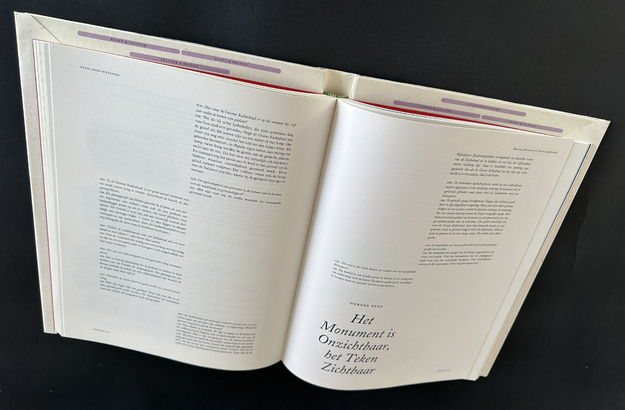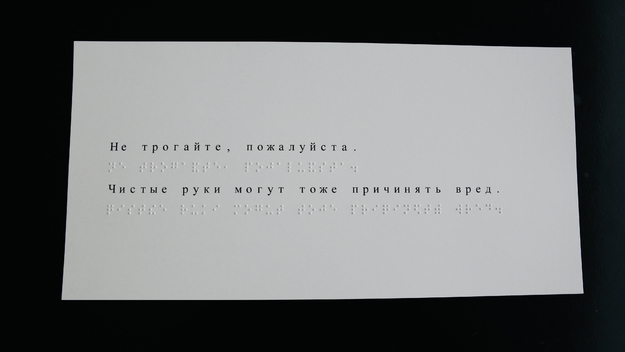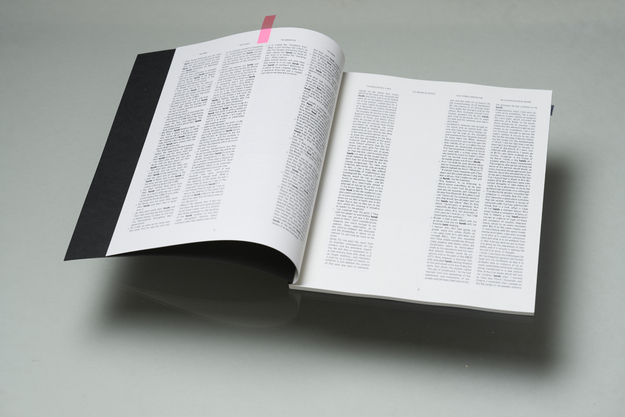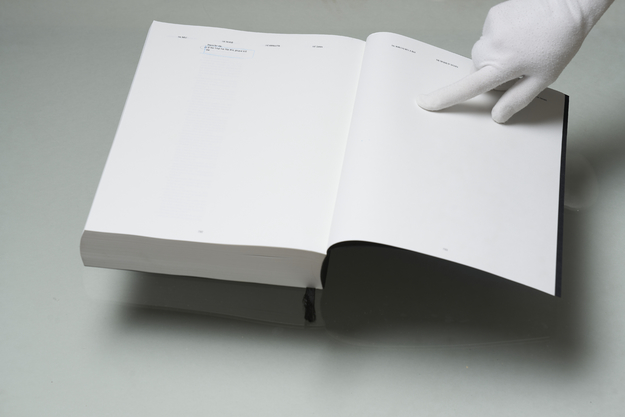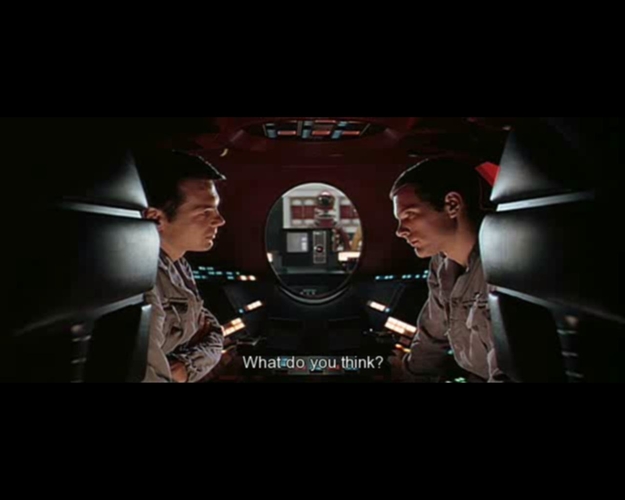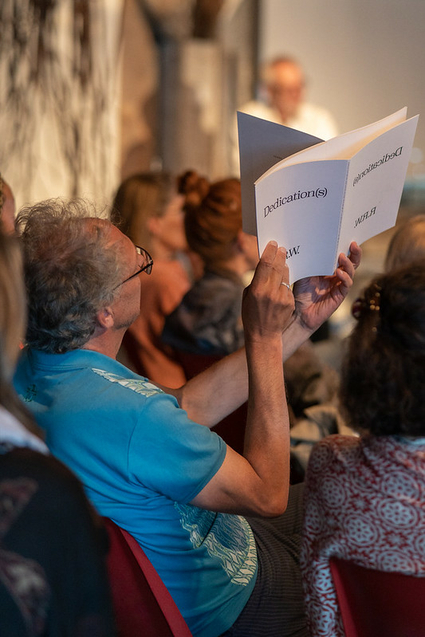For the first half of the evening, Willem and Annelies were seated at a steel table onto which a camera was installed facing downwards, filming books and hands on the table so that we could see what the speakers were pointing at.
Allocations: Hypertext in print
Willem began by introducing two of his own books. The first one was Allocations, the catalogue of the garden and art show Floriade in 1992. The curator of the Floriade and member of the editorial team for Allocations, was in attendance, and Willem asked him to weigh in. He recalled the editorial process: “We studied together in Groningen Art School, and Willem was the logical choice, because we were in the middle of going from print to digital. So Willem was invited and came up with a brilliant idea that challenged our editorial perceptions.“
Willem explained: “You were collecting this big catalogue of texts around the exhibition. And you asked me to make a design that shows the interconnections between all these texts. So I said, okay, then we have to make a hypertext.“ The assignment, however, was to create a “real“ book befitting the renowned exhibition. Trying to find a compromise, Willem and the editors identified the themes of the contributions: it was all about art, culture, and nature. “So I said: We can make an expression in the shape of the book that articulates the emphasis of each contribution in the book.“, Willem remembered.
In order to translate this ambition into the book’s graphic design, they agreed to let each paragraph’s thematic content determine its position on the page: “I gave the editors this horrible task of going back through the whole body of text and categorise every paragraph…and they did.“
This way, every paragraph of the substantial catalogue was labeled by theme, or rather, intersection of themes: nature/culture, nature/art, culture/art.
Only rules
“An automatic rule for a playful layout.“, Willem concluded. “The book is actually very simply following the exact instructions of the editors’ labeling, without any arbitrary design decisions.“ He pointed out a few examples in his copy of the book on the steel table.
“The fewer rules, the better, the clearer the design becomes. I don’t even go to a new page with each new chapter or article. Just follow the rules of the logic, and let the rules of that logic make a playful design rather than me, as a designer, making arbitrary decisions: something that I always found very difficult. Nothing arbitrary here, only rules. That’s something you will also find in other books that we present tonight.“
Awards for the Arts
The second book Willem showed us was also an art catalogue: The 1996 catalogue of the Amsterdam Prizes for the Arts. He remembered feeling contrarian about the cause: “I have difficulty with this whole self-congratulatory thing that we do in the arts and in other sectors by giving each other awards. I thought: the only thing you do with a catalogue like that is look up yourself and maybe your friends.“ Anyone not featured in the catalogue themselves would have little interest in it. “So I proposed to make an alphabetical index of the prizes rather than a fancy, shiny catalogue. And they accepted it.“
The resulting book is small and unassuming, simply listing the lucky recipients in alphabetical order, as well as the names of the jury members who decided their fate.
It is designed for one purpose: “It’s interesting to check who’s trying to flatter whom this year and whose friends appreciate whose work. I think by now I’m a bit milder about this stuff, but still... it’s sort of a comment on how these award systems work.“
With this, he handed the baton over to Annelies.
Strolling through Tate Modern, anno 2006
Annelies began by taking us back in time to walk along with her through the 2006 Fischli and Weiss retrospective at the Tate Modern in London.
She showed a film fragment from The Point of Least Resistance, in which the two artists, dressed in animal costumes as Bear and Rat, try to win their fortune in the Los Angeles art world. They visit a gallery, making appreciative, or perhaps ironic, comments about its abstract sculpture, when suddenly they encounter a dead body on the floor and decide to take it with them in hopes that it might make them rich.
“When I saw this movie at the Tate, I was still a student at Gerrit Rietveld Academy and worrying about money.“, Annelies told us. After watching the movie, she started heading towards another part of the building, where work by Marcel Broodthaers, a fellow Belgian artist, was on show. On the way, she had a fateful encounter. “I was just walking towards the conceptual art floor until I was struck by something on the walls.“
A sentence: Please do not touch. Even clean hands can cause damage.
“I thought wow, what a good work!“, Annelies remembered. “But who made it?“
Of course, Please do not touch is a common request found on many art gallery walls. But even clean hands can cause damage sent Annelies down a spiral of reflections: “Clean hands represent clear conscience. Do I have clean hands? And how many of you have clean hands? I was thinking: beware of those with clean hands. They are the most dangerous ones.“
She loved the work and was eager to find its author, but realised quickly that the sentence was in fact just a practical instruction and not a conceptual artwork. Annelies decided to claim it: “I thought, if there is no author and it’s from nobody, then it will be from me.“
Intervention: You can not live without making your hands dirty
Annelies’s started working with the sentence: “The first idea right away was that I wanted to put Braille underneath the text on the walls of Tate Modern. But, of course, I had just graduated and I didn’t know how to do that. And I tried all kinds of things, I tried to convince the director, but nothing worked. So, then — “
“You tried to convince the director of Tate Modern?“, Willem interrupted.
“Yes, I made an appointment with the director of Tate Modern.“, Annelies confirmed, and continued undeterred: “But I couldn’t get in. So, I thought, okay, maybe I have to seduce a security guard. But then, eventually, I realised I have to start with myself.“
In preparation, she has the sentence translated into a number of languages and printed on white cardboard, with the Braille translation underneath.
“My idea was to sneak into the museum and leave the cards there so people could see them.“ She didn’t want fame and acclaim: “I didn’t want to put my name as a mark. I just wanted to know that it’s from me, and for people walking around to stop and have the same wonder I experienced.“
“The Braille is there to help them discover the wonder?“, Willem asked, and Annelies explained: “For me, it’s the inevitability. You cannot live without making your hands dirty. I wanted to put out a very simple, small, playful, but still profound little work. I proposed it to the Mondriaan Fonds, and they gave me money, so I thought: Well, I’ll just put the Braille underneath the text in the Tate, and I’m finished. That was before my graduation, and when I graduated, I had a very complex work.“
The “Please-do-not-touch-even-clean-hands-can-cause-damage-bible
At first, Annelies also envisioned a live performance in the form of a discussion between scholars of religion and philosophy on the topic of her sentence. Instead, she decided on containing this discussion inside of a book.
She reimagined Sol Lewitt’s words, The idea becomes a machine that makes the work as The idea becomes a machine that makes the book, and took them at face value: “I started to make a book, like a crazy Bible. The Please-do-not-touch-even-clean-hands-can-cause-damage-bible.
This bible is one book consisting of ten book bodies, and Annelies, wearing black cotton gloves, began to drop them onto the table one after the other: “Please! Do! Not! Touch! Even! Clean! Hands! Can! Cause! Damage!“
“This is like…ten kilos of books“, Willem remarked.
“I was asking myself, how do wars start?“, Annelies began to explain. “
For example, people talk and fight in the name of a religion, but maybe they didn’t read the original text, or they just scrolled or googled from there to there to there. So what is it that they read, then?“
She chose eight books to participate in the great discussion of her sentence: the Christian Bible, the Talmud, the Kama Sutra, the Koran, The World as Will and Idea by Arthur Schopenhauer, The Origin of Species by Charles Darwin, and Zarathustra and the Interpretation of Dreams by Friedrich Nietzsche.
Each volume of Annelies’ book contains excerpts from all of these texts, but only sentences that features the volume’s titular word. The volume Please, for example, includes all instances of the word “please“ being used in the Bible, the Talmud, The Origin of Species…
“It’s actually a reverse concordance.“, she said. A concordance is a book that helps the reader locate instances of a particular word in the Bible. Annelies’ book, on the other hand, helps the reader not only locate but also compare instances of the individual words of one sentence across her selection of texts. “It’s quite an old work, it’s like a study book for me now. Maybe I will find new sentences that I can make into another book. Let’s see.“ With that, she began a theatrical reading.
Please
The first volume, of course, was Please. Annelies chose a passage from the Talmud: “You may go and marry any man that you please. The essence of a deed of emancipation is the words: Behold, you are hereby a free woman. Behold, you belong to yourself. […]“
Time being limited, she immediately moved on to Do.
Do
Annelies read from Zarathustra:
“Who art thou?, asked Zarathustra vehemently. What dost thou here? And why call’st thou thyself my shadow? Thou art not pleasing unto me.
Forgive me, answered the shadow, that it is I, and if I please thee not well, O Zarathustra, therein do I admire thee, and thy good taste. A wanderer am I, who hath walked long at thy feet, always on the way, but without the goal, also without the home, so that verily I lack little of being the eternally wandering Jew, except that I am not eternal, and not a Jew.“
“And so on and so on.“, she cut herself short in order to move on to Not.
Not
Annelies traced a gloved finger across one of the many pages of Not, while next to her a metronome kept a steadily ticking pace: “Not, not, not, not, not, not, not, not, not, not, not, not, not, not, not, not, not, not, not, not, not, not, not, not, not, not, not, not, not, not, not, not, not, not, not, not, not, not, not, not, not, not, not, not, not, not, not, not, not, not, not — oh! All the rivers run into the sea, yet the sea is not full. To the place from which the rivers come, there they return again.“
And another sentence from the Bible: “The eye is not satisfied with seeing, nor the ear filled with hearing. That which has been is what will be. That which is done is what will be done. And there is nothing new under the sun.“
She went back to tracing the page, an artist seemingly overwhelmed by the magnitude of her work: “Not, not, not, not, not, not, not, not, not, not, not, not, not, not, not, not, not, not, not, not, not, not, not, not, not…“
Then read a last example, this time from the Talmud, after which she decisively closed the book and slammed it onto the metal table: “I am not able to bear all these people alone, because the burden is too heavy for me. If you treat me like this, please kill me.“
Touch
“You understand now that you can go on and on and on and on.“, Annelies interrupted herself. “So I will just go through Touch very fast“. She chose a well-known excerpt: “But God did say: you must not eat fruit from the tree that is in the middle of the garden and you must not touch it or you will die.“ And from the Kama Sutra: “Her anger, never neglecting on the bed when he turns his face towards her, touching any part of his body according to his wish.“
Clean
We skip Even to be able to devote some time to Clean, one of Annelies’ favourites.
She balanced a blue marble pages with the words: “A condition of doubt concerning an object of uncleanness that floated among the water….“
The marble fell, and she turned to another bookmarked page: “Drawing a distinction between an uncleanness at rest and one on the move.“
Another example from the Talmud:
“If a witness says, you have contracted uncleanness, but he says, I have not contracted any uncleanness, he is regarded as clean. If two witnesses say, you have contracted uncleanness, and he says, I have not contracted any uncleanness, we arrive at a dispute.“
Unable to stop, Annelies continued reading aloud:
“If a tree standing in a public domain had within it an object of uncleanness, and a man climbed to the top of it. And the doubt arose as to whether he did or did not touch the object of uncleanness. Such a condition of doubt. If a man put his hand into a hole in which there was an object of uncleanness, and there is doubt whether he did or did not touch it. Such a condition of doubt. If there is doubt whether he did or did not touch anything. Such a condition of doubt. However many the doubts about doubts about doubts that one can multiply, et cetera, et cetera.“
She looked up and told us: “I thought the Talmud was fantastic“, only to immediately continue reading: “What color is regarded as red? One like the blood of a wound, black. Like the sediment of ink. If it is darker, it is unclean. And if lighter, it is clean…“
Damage
After this, we skipped Can and Cause to wrap up the performance with Damage.
Annelies asked Willem to read an excerpt from this volume, pointing out: “I would expect that The Origin of Species contained the word damage, but it is not the case.“
“It starts with an empty column.“, Willem confirmed. As it turned out, many of the featured books don’t mention damage at all: “Damage starts with empty columns for the Kama Sutra.“, Willem considered. “No damage in there? The World as Will and Idea —Schopenhauer, no damage. Darwin, no damage.“
Finally, Annelies asked Willem to give the last word to a banal story from The Interpretation of Dreams:
“The whole plea for this dream recalls vividly the defence offered by a man who was accused by his neighbour of having returned a kettle in a damaged condition. In the first place, he had returned the kettle undamaged. In the second place, it already had holes in it when he borrowed it. And in the third place, he had never borrowed it at all. A complicated defence, but so much the better. If only one of these lines of defence is recognised as valid, the man must be acquitted.
Okay. Enough?“
— “Enough, thank you.“
Q&A — A totally different story
Then, it was time for questions. “Why did you choose these eight sources?“, someone wanted to know.
“I definitely wanted the religious ones.“, Annelies responded. “And you can discuss if these are the eight right books. You can do it with other eight, it becomes another book. I asked a lot of writers in my social circles what they would choose, and these were the highest on the list. But this machine, you can do it with every sentence and with every book. So I hope I will be able to find another sentence and make another book, maybe in another language. It would become a totally different story.“
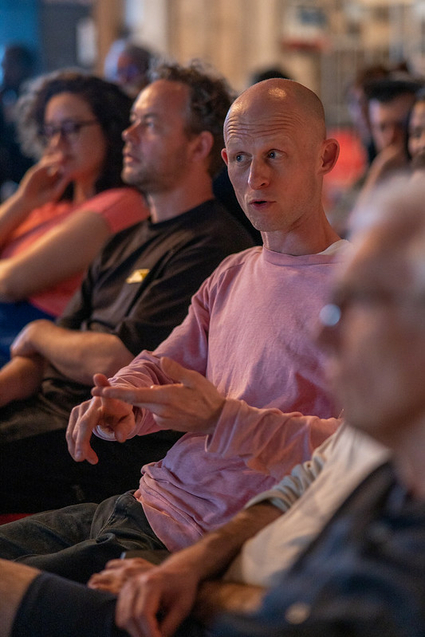
“How long did it take you to compile all this information and make the books?“, someone else asked.
“It took me a long time“, Annelies admitted — “but it was long because I was not sure what to do. What I really wanted was to put Braille underneath the sentence in the Tate. So for me, making the book was the second choice.“
Willem chimed in: “I checked. The Fischli and Weiss retrospective in the Tate Modern was 2006. The date in the book is 2012.“
“But it’s not that I worked on it all that time“, Annelies clarified. “I got that idea when I still studied, it was the first work I asked funding for from the Mondriaan.“
“You actually had funding for doing this stealth Braille insertion in institutions, right?“, Willem inquired. “But that never worked?“
— “No, unfortunately not.“ In fact, when Annelies finally went back to the Tate Modern to check, her sentence had been removed from the wall.
Despite this, the work still has a future in her mind: she would like to translate the book into different languages, and also have the sentence comment on war tribunal proceedings.
“I searched the whole tribunal in The Hague. You can find all the testimonies of the victims, so I also searched this sentence in all the testimonies. And then you get absurd Beckett plays.“
Robin Waart — What are you thinking?
After the break, Robin Waart began by not introducing himself: “We’re cutting out all the CV and everything, you can look it up anyway if you want, and if it matters.“
Instead, he introduced his first book, Thinking In Pictures: “It collects 451 instances of the question “What are you thinking“ and variations asked in different movies into a thousand-page book, where every spread is one minute in a 500 minute long fictional movie.“
For each film still, the book lists the title of the movie, the time code it is taken from, the director, the year, the country, and the original language. A thirty-page index at the back of the book additionally indexes all of the actor’s names, the years the movies were made, whether they are onscreen or offscreen, a woman or a man — “So for film nerds, it could be a guessing game.“
The detailed indices he creates for his books, Robin reflected, are somewhat similar to Annelies and Willem’s books: “They give you a lot of information about these films in a very exaggerated way. It’s not very unlike their concordance or the alphabetical organising.“
Beginnings: Part One
The second work Robin introduced is a collection of first pages, or rather, pages with only the words Part One written (printed) on them. “It’s also an outtake from a collection, with different sizes and different fonts, of different ages, differently discolored.“
Part One is a book that never quite manages to start: “I tear up books. I take pages out of books. They’re from a hundred and one different books, and they came back together in a new book. It’s about dismantling and reordering the material, but it’s equally a book about avoiding or failing to make a book.“
Robin printed three editions of Part one, the first one consisting of 101 copies, the second of 202 and the third, of course, of 303.

He also had a customised bookshelf fitted for the first edition, a place specifically for them:
“Those books stayed together. It was something that caused a bit of a fight between me and the designer, because we were supposed to distribute them. The idea of a book is something that circulates.“ This argument was resolved through the printing of the second edition.
“I also tried to break with this idea that one work you do is old and another new“, Robin reflected: “Hence the reprinting of the part one book, which makes total sense to me, to keep the first thing you did in circulation as a sort of introduction or prime example. It’s where I’m coming from.“
What is the place of books?
“Where do books go, where do they fit?“, Robin wondered, — “What’s their place? On the one hand, it’s on the shelf, on the table, on the other hand, it’s also in the arts.“
Robin Waart's publications 'Love/Evol' and 'Part 1' -
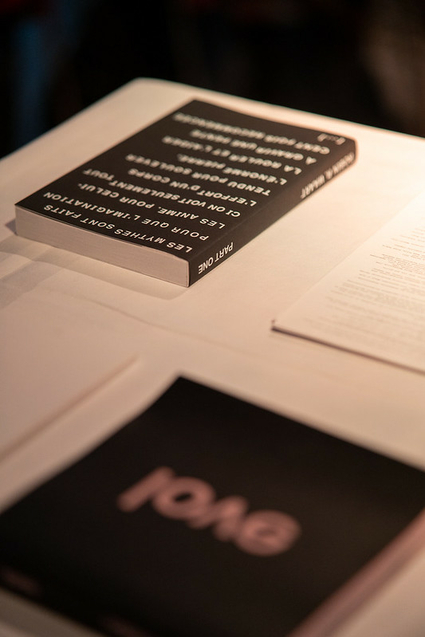
Over time, he made it a thing to build custom shelves for each of his publications: “I’ve been trying to connect the books through these containers. The book itself is a container that then has its own home. We tend to think of books as similar to laptops, it’s only on when it’s open. The thing I always emphasize for books is that they’re still books when they’re closed. They’re actually working when they’re closed. So I like to think about whether it’s okay if you don’t read all the books you have, if they’re just sitting there staring out at you from the shelves, their spines toward you.“
Would you…?
“The third book I did wasn’t really a book, but a printed project, which went back to the film stills.“, Robin continued. This work, titled Would you…?, is a series of 16 postcards of moments from movies in which one character asks another to go on a date, for dinner, or to the movies. “As a set, you could see them as a story, an unbound book.“, Robin said. The place he selected for displaying this set was a card rack: “It’s already something that turns, circulating in a different sense, which I really liked.“
He added: “I’m asking someone to go to a movie with moments where it’s asked or proposed in a movie. It’s quite self-referential. All the projects I do repeat something, and I was never sure whether to call it obsessively, or call it literally… but sort of becoming less worried about the label.“
Dedications
He also repeated the concept of Part One, collecting similar pages from different books, in another publication eight years after the first, this time collecting dedications with anonymous addressees, their names represented only by three initials.
“This book has 27 dedications, an alphabet plus one. My intention was originally to find dedications that go from A to Z in this three letter form, from A.L.M. to Z.F.G., the initials of people that were probably essential for the writer to make the book.“
Robin Waart presenting 'Dedications' -
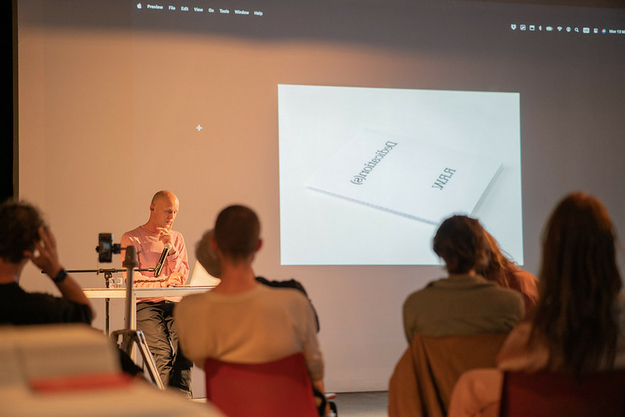
It proved difficult to find all the required letters, Robin shared: “I settled for five S’s and four A’s, still from 26 different books, breaking my own rule. One way to stop self-torture is to break your own rules, as a life and book lesson.“
He continued: “Most books are dedicated to parents, lovers, children, but there’s quite a lot of them dedicated to someone whose name is not totally clarified. I like the mystery of that. They are left in their anonymous, anonymized condition, even though they’re so important. On the one hand this honors their privacy, on the other it makes you more curious.“
Connection through relations
“I build these archives of connections which circle around certain topics, and slowly you find out they relate.“, Robin mused. One way they relate is through questioning the relations: Thinking Pictures wonders about the contents of other people’s minds, Would you… takes something of an awkward outsider’s view on the intricacies of communication, and Dedications reflects on the relationship between writer and reader. The next book Robin introduced, fittingly, was about Love.
Evol/Love
After Dedications, Robin circled back around to film stills, collecting moments from movies when characters say the word “love“. Next to a beautifully designed book, this work also manifested as a series of billboards across Amsterdam.
“I imagined making a book on the street, a book in public. The billboard series here in Amsterdam had the text of the entire book, all the sentences about love.“
Like Annelies and her reverse concordance, Robin queried a concept by collecting instances of a word and letting them enter into conversation by placing fragments next to each other. He read an example: “God is love, and this one says: And what’s love in Latin?“
Cover of 'Evol/Love' - Nibor Traaw, Evol/Love . Offset on pink paper (2020)
(Photo Ayako Nishibori)
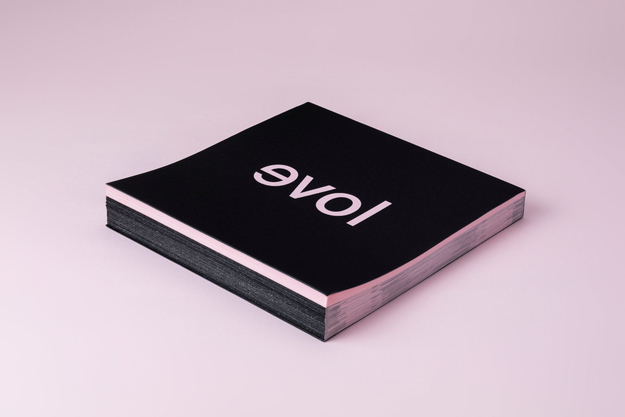
An animal that speaks
Robin then shared impressions from a 2021 exhibition featuring his work at Artis=Book in Groningen, titled An animal that speaks.
Penguins
The exhibition featured a procession of ceramic penguin figures placed on top, along the exhibition space’s skirting board. Robin explained that they referenced the prominent publisher Penguin Books: “You judge a book by its cover, as a way of saying that they have to attract you for you to buy them. A lot of publishers have a logo that is made up of letters, a lot of other publishers work with an animal, and the most well-known instance is Penguin. So, these penguins are stand-ins for books.“
Group photo
From the same exhibition, Robin showed us a photo of his four publications, each on its own custom wooden shelf. “They’re all sitting there, showing their cut edge.“, he pointed out, the opposite of the side you normally notice when theyre placed in a bookcase. “I try to make ‘work’ of all sides of the books. I haven’t really done much with the top and the bottom yet, but who knows.“
This “group photo“ also prompted more general reflections: “I was thinking earlier that maybe they’re not necessarily neurodivergent books, but I do hope that they are atypical books, that there’s something weird about them, even though they look like something you recognize.“
And: “One of the reasons I like books is that they’re an exhibition you can take home. I try to make exhibitions that you can take home.“
Mirrored library
Another exhibition Robin curated was Wörthersee, Wörtersee at the Austrian art space Kunstraum Lakeside. He was invited to propose an exhibition starting from their library and ist contents, which was housed in of two shelfs in the space, one full of books from artists who had exhibited there over the past twenty years, the other empty. “Instead of deciding to work with the contents of one of the books, I decided to work with their surface, or their objectness. I worked on making a list of all the books, and tried to find a second copy of each to fill the empty shelf. So it was centered on copying, doubling, repeating, in the most literal way.“
It also shows a shift away from collecting pages from books or moments from films, and towards collecting books as objects and the social relationships that made them posible, asking the artists, authors, publishers and exhibition spaces that published them for a second copy.
“Wood you?“ A collection of outsides
This transitions into Robin’s current ongoing project: A collection not of insides, but of outsides. “I started stumbling on these books whose covers imitate wood.“, Robin explained the theme. “So there’s a constant circling around, returning back to just a few ingredients. Pages. Subtitles. Sentences. Words. Then moving to the containers. The cover. The spine. The circumference of a room.“
He continued: “You could argue that wood and paper are the same material. It’s very stupid, of course, books that look like wood. But at the same time, when we spend more time with something that’s really stupid, sometimes it turns out to be really interesting.“
The collection of wood-books will be shown in a small exhibition space in Paris. Again, Robin is trying to find two copies of each book: “One for people to handle. And one that will end up in the shelf. Then I will make a book that looks like wood, describing the thematic micro library it will be a part of. And maybe that’s the end of my practice.“ He looked up with an apologetic smile: “You are as good as your first or your last work.“
Q&A — Can a book be…?
During the Q&A, someone asked about the dynamics of something becoming interesting through sustained attention, and the danger of a work that follows very simple rules, such as collecting wood-like books, to slip into the realm of the banal.
Robin answered: “Maybe I’m collecting synonyms? I mean, it’s not that interesting to just have a collection of things that are similar just for the sake of being similar. I hope to find a way to make it something more than just a collection. That’s, of course, the risk. This ‘something more‘‚ it’s not a given.
Postcard 'To speak with the words of others...' by Robin Waart -
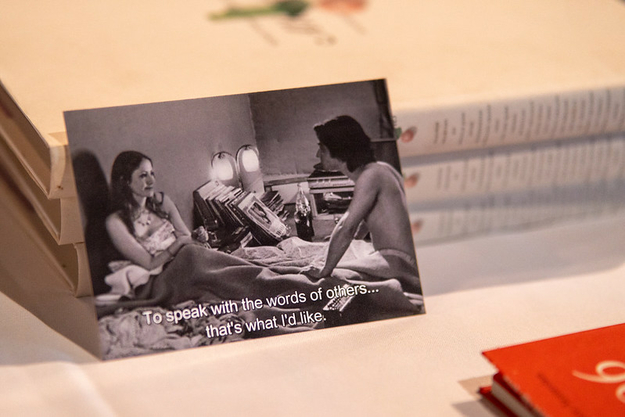
Another guest wanted to know if this could be a collaborative artwork: “If I find a book with a wooden cover, can I send it to you? Or do you want to collect it yourself?“
“That would be lovely“, Robin replied — “But I would buy it off you, I don’t want it to be at your expense.“ He added that the doubled library was also only possible through gifted books, as there was not enough money to purchase hundreds of new copies, and not just because there wasn’t enough budget, also because a lot of the times publications in small print runs had become impossible to find.
Guests at 'The Artist Makes the Idea that Makes the Book' -
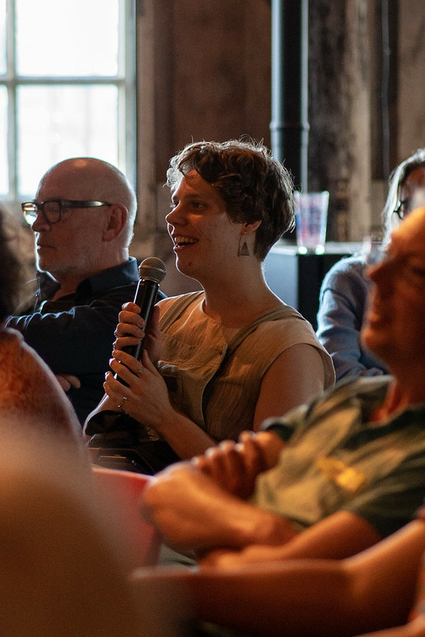
Someone else asked about Robin’s work with film stills: “Can you explain the drive to turn them into a book, rather than just leave it in media where it originates?“
“I never want things to just be a book.“, Robin explained in response: “But I want the book to be an extension of something. For instance, a slideshow of movie stills. For film, my argument is that every second in film is made out of 23 or 25 images. So I go back to the smallest denominator in the material that I’m working with, just a still or a screen grab. Taking apart the film or reducing it to where it starts from. I hope to open up the material that you see in each movie. I’m trying to make a book that’s kind of a film. I try to think, can a book be a film? Can a book be a set of cards? Can a book be an object? An exhibition? Can an exhibition be a book?“
Jenny Konrad looking at books -
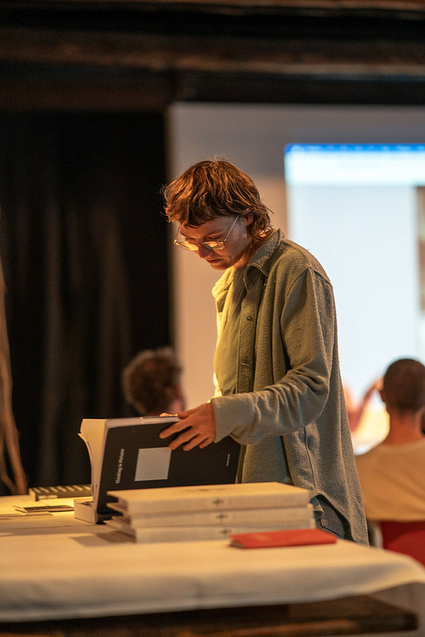
Original Event Information
Robin Waart
Robin Waart's work begins with the words of others. He uses repetition and collecting as a framework for projects and installations with text, printed matter, movie stills, photography and book pages explore what it means to do, and look at, the same thing over and over.
During this evening, Robin will speak about his recent projects and present the publications he made until now, hiding in plain sight, all reflecting on themes of repetition and the difference and/or similarity between a place and a book. For an impression of Robin's work, read the blogpost 'Robin Waart is an artist who makes books who makes books'!
Robin studied Classics in Amsterdam. He received his BA from the Gerrit Rietveld Academie, Amsterdam, and MA from the Royal Academy of Arts, The Hague. Publications: Lakeside Library/Library Ideal (2024), Footnotes I have never seen (2022), An animal that speaks (2021), Evol/Love (2020), Dedication(s) (2018), Thinking in Pictures (2010), Part one (2010, 2011, 2024.
A.W. Doom
Annelies Wina Doom is a conceptual artist, curator and wildly associative thinker. This manifests in her project 'Please Do Not Touch, Even Clean Hands Can Cause Damage', where every word becomes a book, and every page juxtaposes fragments of timeless texts, often to surprising, inspiring and provocative effect. With a lecture-performance, Annelies will lead the audience down the rabbit hole of associations this work opens up.
Annelies studied Fine Arts at the Gerrit Rietveld Academy. Her work 'Please Do Not Touch...' was featured in the 2015 exhibition Paths to Paradise at the Rijksmuseum Twenthe. She is one of the initiators and curators of the a/Artist project.

Willem Velthoven
Willem Velthoven is one of the founders of Mediamatic (in 1983) and of the a/Artist project (in 2021), and an award winning designer and cultural entrepeneur in the fields of new media and the intersections of art, nature, and biology.
For this talk, Willem rediscovers two publications he designed in the 1990s. In 1992, he gave the official publication of contributors to the Floriade, an international exhibition and garden festival hosted every ten years in the Netherlands, an algorithmic spin inspired by a budding world wide web. In 1996, after having won the 'encouragement price graphic design' from the Amsterdam art council the previous year, he was tasked to design the annual catalogue celebrating the years' winners, and did so in an unconventional manner. As a designer who has long since moved on to pursue his own visions and interests, he will reflect on the unique choices, freedoms and limitations that went into the conceptualisation of these two books.
Willem Velthoven with a bunch of dry Japanese knotweed - Willem chose the Japanese knotweed.
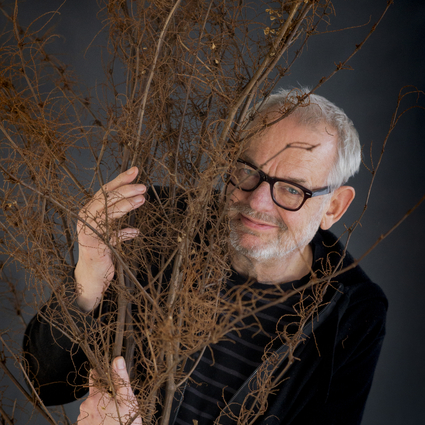
Bring your own book
Since this evening will be all about books, we encourage you to also bring a book you love or one that influences your practice. There will be opportunity to show and discuss it with others during the break!
Information
a/Artist Meeting: The Artist makes the Idea that makes the Book
Monday 13th of May
17:30 - 20:30
Tickets (with vegan meal)

